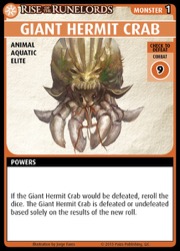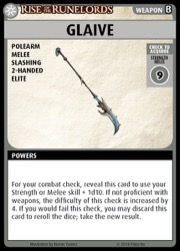 ryric
RPG Superstar 2011 Top 32
ryric
RPG Superstar 2011 Top 32
|
| 1 person marked this as a favorite. |
I'm pretty good with probabilities in my head (I've been a math teacher), so I'm usually the one advising my table on odds. I tend to use something like method 1.
Of course, this comes back to bite me when my friends are asking if I need a blessing and I'm like, "Nah, I've got a 96% chance to make this roll," and then it fails.
 James McKendrew
James McKendrew
|
(The date says February 14 but I don't think that's correct)
I like throwing everything onto the very last check of the scenario, whether it be a close or combat check. It's fun rolling 8 dice with a plus 7 when you only need a 15. ;-)
Over on the Obsidian forums, I referred to this as Alpha-striking (Battletech term), which caught on. I created a thread for screen-shots of epic Alpha-strikes.
http://forums.obsidian.net/topic/86610-alpha-strike-screen-shots/
| Longshot11 |
| 1 person marked this as a favorite. |
I prefer using method 2 on my table. However, when we're temp-closing for the final villain showdown - we're going Method 4. Basically, we throw everything and the kitchen sink on the villain (and sometimes that even means some characters will die if we fail), so if a character has a 1/12 chance to blow his temp-close check - they still get a full blessing (assuming we lack another resource to bump him one point).
 Vic Wertz
Chief Technical Officer
Vic Wertz
Chief Technical Officer
|
If this blog interests you, you may want to check out the dice calculator at anydice.com. (To see what the odds of our primary example—1d8 + 1d6+2 with a difficulty of 10—are, you'd enter "output 1d8 + 1d6+2" at the top, click the buttons "Table" and "At Least", then hit the "Calculate" button. Find the result "10" in the table, and you'll see the odds of getting at least 10 on that roll are 56.25%.)
| Parody |
| 1 person marked this as a favorite. |
Do Bless Low Skills
Supporting isn't about how large a die you add to the check, it's about attaining the desired result. Getting rid of a particularly annoying card, avoiding a hand flush or other very bad thing, (temp) closing a location, and occasionally even acquiring a desired boon are all times that you may want to use whatever means you have available. Sometimes your party members have other cards or abilities that can help, but usually it means Blessings. Don't be afraid to use them when the result is worth it.
Also, in Guild play, don't forget your reroll item! :)
| skizzerz |
Gaby Weidling frequently embraces the "Count every die as a 1" strategy.
A friend of mine's dice also frequently embrace the "count every die as a 1" strategy, much to the table's chagrin. I remember the time where he managed to roll a 1 on every single die (there were like 8 of them), when success was just 3 more than that roll. It was the final roll against the villain, so we threw everything we had at it to "make sure" it was successful.
| Frencois |
Thinking of it, we tend to follow a non written metamathrule that looks like:
- If you don't care (like you encounter a boon that is not great and you aren't short in cards left in your deck), don't waste ressource, throw your basic di(c)e
- If it's a standard bane (not a big deal if you lose), we somehow use the "Count dice + sides then divide" version (which gives by definition more than 50% chances
- If it's a important boon or bane (someone in the group will really benefit of the bane, the bane has a very nasty outcome if undefeated, or you really need one more card in your hand), count dice as 2 (or 3 for d10 and above)
- It it closes (defeating the henchman that will give you the opportunity to close, the closing itself, a not to nasty villain that is not cornered but has limited locations to escape and we still have time), count dice as 2 and roll at least 3 dice
- It it a must win, except final fight (cost on the blessing deck too high if failure...), count every d4 and Dd6 as 1 and all other dice as 2and roll at least 4 dice
- Final fight, throw all you have (we managed to roll 22 dice once with 6 players)
 Vic Wertz
Chief Technical Officer
Vic Wertz
Chief Technical Officer
|
| 1 person marked this as a favorite. |
Maybe it's a little tricky, but we take 1/2 the first die + 1/2 the second die + 1 + 1/2 the third die + 1/2 the fourth die + 1 etc + bonuses.
That's one of several different expressions that get you to the same result as "Add up the number of dice and all their sides, then divide by 2". I personally do that with a method that falls in between the one Shannon described and the one you described: I add half of the max value of each die, then add 1 for every 2 dice. So my "1d8 + 1d6+2" math is 4 (half of the d8) + 3 (half of the d6) + 1 (for two dice in the roll) + 2 (for the modifier).
| Mechalibur |
I was reminded in the Pathfinder Adventures app today how these all fail during Scaling Mhar Massif in all those Death Zones.
Yeah that one really screws with my head math. I keep failing checks I thought would be easy, or beating them by a lot after spending way too many resources.
| ShannonA |
Addressing the question of what dice-counting methods we actually use:
My table tends to count dice with method #2 (half the number of sides), but then if it's important we try to throw in an extra dice or two past when the expected value matches the target. It's an easy to count ad-hoc method.
For the important stuff, we try to get close to method #3 (count each die as a "2"), though on one our recent games I was throwing seven or eight dice ... and missed with that method. Doh! Our villain did _not_ get beat on that encounter as a result.
 Tiefling Commoner
Tiefling Commoner
|
I dunno, things seem "quite dire" for me all the time. I've lost track of the number of times when I've run up against an obstacle that's going to keep pounding me for insane damage unless I succeed on a check using one of two skills that I just don't freaking have. So I toss a Blessing, roll 2d4, and hope for the best. Surprisingly, it's worked a fair number of times!






